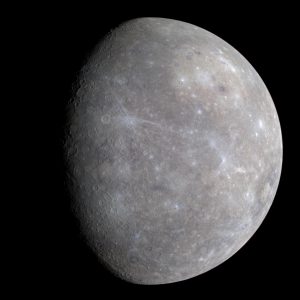19 September 2017
Researchers identify ‘substantial’ amount of Mercury’s water ice
Posted by Lauren Lipuma
By Madeleine Jepsen
Mercury may have more exposed water ice held in cold traps than previously thought, a new study finds.
Researchers have identified three new craters and four small-scale cold traps on Mercury filled with surface ice and suspect the planet may harbor many smaller patches of exposed ice too small to observe directly. The newly observed ice makes a substantial contribution to the amount of exposed ice thought to exist on Mercury’s surface, which the researchers estimate to be approximately 3,400 square kilometers (1,313 square miles), or just smaller than Rhode Island in size. The researchers reported the findings in a new study in Geophysical Research Letters, a journal of the American Geophysical Union.
Scientists first suggested Mercury might have water ice in the 1990s after Earth-based radar data revealed bright spots at Mercury’s poles. While other studies have estimated the contribution of ice covered by other materials, this study is the first to look at exposed surface ice in these three craters, said Ariel Deutsch, a graduate student in planetary science at Brown University in Providence, Rhode Island and lead author of the new study.
Quantifying the extent and location of Mercury’s exposed ice is important for understanding how water came to the planet and how water is distributed in the inner solar system, Deutsch said. It may even help explain why there isn’t as much ice on the surface of Earth’s Moon, which is similar to the surface of Mercury.
“The big debate these days is why is the Moon so different from Mercury, and what process is operating on Mercury that seems not to be operating on the Moon to produce these huge deposits of ice where the ice would be stable based on temperature,” said Paul Hayne, a research scientist at the NASA Jet Propulsion laboratory in Pasadena, California, who was not involved in the new study. “We know that the kinds of thermal environments exist on the Moon that exist on Mercury that should allow ice to be stable, yet we don’t see these massive ice deposits on the Moon.”
“If we can transfer any of this knowledge from Mercury to the Moon, that would be really important,” Deutsch said. “There’s a lot of interest in this for science and exploration.”
While some debate remains about the source of Mercury’s ice, Deutsch said it was most likely delivered by a comet or asteroid. Another explanation is Mercury’s exposure to solar winds containing protons could have combined with oxygen and hydrogen on the planet to form water.
In the new study, researchers used data from NASA’s MESSENGER spacecraft, which orbited Mercury from 2011-2015, to map out how different areas of Mercury’s surface reflect light from the sun. Gregory Neumann, a research scientist at NASA Goddard Space Flight Center in Greenbelt, Maryland, Instrument Scientist of the MESSENGER spacecraft and co-author of the new study, accounted for the spacecraft’s position when the measurements were taken, since different measurement angles can result in different levels of reflection from Mercury’s surface.
Using these measurements, the researchers detected bright areas that indicate the presence of exposed ice near Mercury’s north pole. The planet’s rocky terrain and ice covered by other materials appears darker, while the reflection of exposed ice causes it to appear as bright areas, the researchers said.
“That’s really the telltale sign that water ice might be sitting at the surface, and then when you start to pair that with other pieces of data such as extremely low temperatures and bright radar signatures, then you can add other pieces to the puzzle that really tell you water ice might be sitting up at the surface,” Deutsch said.
The researchers found three craters filled with newly discovered ice roughly 31 to 50 kilometers (19 to 31 miles) in diameter, and four new small-scale cold traps, roughly 2 to 5 kilometers (1 to 3 miles) in diameter, containing surface water ice. The small-scale patches are some of the smallest directly observable through MESSENGER data and suggest there may be more ice in even smaller quantities, according to Hayne.
The existence of small patches of ice will be an important topic for future exploration of Mercury, since MESSENGER’s orbit only allowed it to collect surface reflectance data for its north pole, Hayne said. Until scientists can observe Mercury’s south pole, which has temperatures capable of sustaining ice, the total amount and distribution of Mercury’s ice will remain a mystery. While more exploration and research is needed, this study is a step toward understanding how Mercury’s ice is distributed, according to Deutsch.
“This study looks at smaller spatial scales that haven’t been looked at before, so it kind of completes the picture in the sense that we’re seeing that the ice on Mercury exists down to very small scales compared to what was previously known,” Hayne said.
— Madeleine Jepsen is a science writing intern at AGU. This post also appeared as a press release on the Brown University website.



 GeoSpace is a blog on Earth and space science, managed by AGU’s Public Information staff. The blog features posts by AGU writers and guest contributors on all sorts of relevant science topics, but with a focus on new research and geo and space sciences-related stories that are currently in the news.
GeoSpace is a blog on Earth and space science, managed by AGU’s Public Information staff. The blog features posts by AGU writers and guest contributors on all sorts of relevant science topics, but with a focus on new research and geo and space sciences-related stories that are currently in the news.